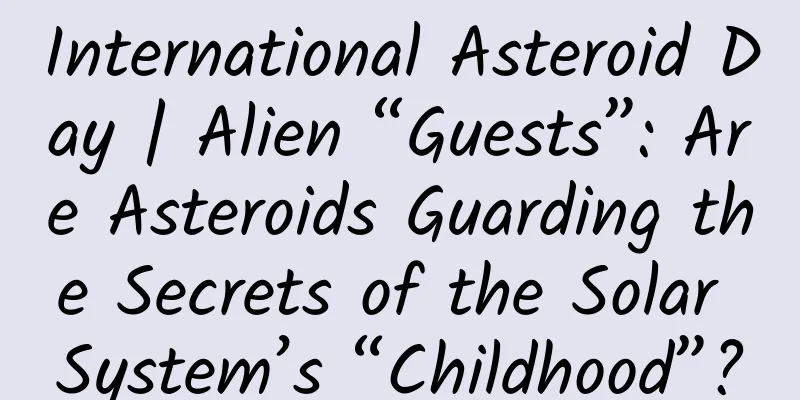International Asteroid Day | Alien “Guests”: Are Asteroids Guarding the Secrets of the Solar System’s “Childhood”?

|
Today is International Asteroid Day. According to the geophysical terminology approved by the National Committee for the Approval of Scientific and Technological Terms, an asteroid is a celestial body in the solar system that orbits the sun and is much smaller in size and mass than the eight planets. For the vast universe, or even for our solar system, an asteroid is just a drop in the ocean. However, asteroids actually guard the secrets of the solar system's "childhood". Figure 1. Artist's impression of the Sun in formation and the planetary disk around it. (Image source: ESO) 01A fragment of an asteroid that has been floating for billions of years When the sun was just born, there was a planetary disk composed of dust and gas around it. The planets were born in this disk, of which gas accounted for 99% and solid particles accounted for only 1%. Most of the gas was gradually accreted by the sun, and the solid dust collided and condensed together to become gravel, rocks, etc. They grew bigger and bigger, and eventually became rocky planets like our earth, dwarf planets, satellites and numerous asteroids. There are also some rock fragments that have been cruising in the solar system. They may have been left behind or caused by the collision of asteroids. By chance, it was captured by the earth's gravity and turned into a meteor falling to the earth. If it did not burn up in the atmosphere, it became the most common meteorite on earth - chondrite. One night in 1940, a fragment of an asteroid that had been floating for billions of years fell into the earth. In the violent friction with the air, a dazzling light broke through the silence of the night and finally fell into a small village called Semarkona in northern India. So the meteorite was named Semarkona, and it weighed 691 grams. The Semarkona meteorite belongs to the rarest subcategory of ordinary chondrites. It was not until more than 70 years later that the second meteorite belonging to this subcategory was discovered. Meteorites of this subcategory have undergone the least changes and remain in the most original state, so through them we can understand the environment and conditions when the solar system was formed. After the discovery of the Semarkona meteorite, scientists have carried out a lot of research. To this day, there are still many studies using the Semarkona meteorite as the object to reveal the mystery of the formation of the solar system. Figure 2. Semarkona meteorite, considered one of the most primitive meteorites, contains a large number of millimeter-sized chondrules. The picture shows a 1.5 cm cross-section. (Photo credit: THE PLANETARY SOCIETY) 02 How to measure the age of the Semarkona meteorite The decay of radioactive isotopes can be used as nature's clock. Meteorites contain trace amounts of radioactive isotopes and their decay products. By measuring them, scientists can know when meteorites were formed. What are radioactive isotopes? Aluminum is a very common metal element in our daily lives. For example, Coke cans are made of aluminum. Imagine that the core of an aluminum atom is like a small room where protons (positively charged particles) and neutrons (uncharged particles) live. Ordinary aluminum atoms, we call it aluminum-27, because it has 13 protons and 14 neutrons in its nucleus, which is very stable, like a harmonious family. Aluminum-26 is an isotope of aluminum. Its nucleus lacks a neutron. This combination is not very stable, and then it becomes more stable by releasing energy and particles. This process is radioactive decay. Aluminum-26 will become another stable element, magnesium-26, which includes 12 protons and 14 neutrons. Therefore, aluminum-26 is a radioactive isotope of aluminum. This decay process is very slow. The half-life of aluminum-26 is about 720,000 years. That is to say, if you have a pile of aluminum-26 now, it will take 720,000 years for half of the aluminum-26 to complete its transformation journey. Calcium-aluminum-rich inclusions are minerals rich in calcium and aluminum and are the main components of chondrites. They are the first solids to form the solar system, so their birth time is usually considered to be the zero point of the formation of the solar system, about 4.567 billion years ago. This age is measured by the decay of uranium-238 and uranium-235, with half-lives of 4.468 billion years and 704 million years respectively, and the decay products are lead-206 and lead-207, so this method is also called the "lead-lead" dating method. As the name suggests, calcium-aluminum-rich inclusions are rich in aluminum. Through measurements, it was found that when calcium-aluminum-rich inclusions were formed, the ratio of aluminum-26 to aluminum-27 was about one in twenty thousand. For chondrites, scientists can measure the ratio of aluminum-26 to aluminum-27 when chondrules were formed. Through this ratio and the half-life of aluminum-26, the time when chondrules were formed relative to calcium-aluminum-rich inclusions can be inferred. Analysis of different chondrules in the Semarkona meteorite revealed that the chondrules were born between 1 million and 3 million years after the formation of the calcium-aluminum-rich inclusions, and that chondrules were produced during this period through different thermal melting events at 1.2 million, 1.6 million, 2.1 million, 2.4 million, and 2.9 million years respectively. 03 Are supernova explosions recorded in meteorites? In addition, by measuring the trace amounts of radioactive isotopes and their decay products in meteorites, it is possible to study what the meteorites were like when they were formed, that is, the state of the solar system's planetary disk or even earlier, and what kind of environment they experienced. For example, there are many theories about the origin of the aluminum-26 mentioned above, one of which is that the nearby supernova explosion brought radioactive aluminum-26. Iron-60 is a radioactive element of iron that decays into nickel-60. By analyzing the ratio of nickel-60, nickel-58 and iron-56 in the Semarkona meteorite, scientists have inferred that the content of iron-60 was very high when the meteorite was formed, indicating that in the early formation of the solar system, there was an excess of iron-60 in the nebula material, and it could not have come from the irradiation of the newly born sun on the nebula material, nor from the mixing with the interstellar material. For such an excess of iron-60, scientists believe that the most likely reason is that when the solar system was formed, a supernova explosion very close to the solar system brought newly synthesized iron-60. Further numerical simulations show that a star about 3 light years away from the solar system and about 20 times the mass of the sun exploded in a supernova. The shock wave it produced brought the iron-60 produced in the explosion into the young solar system, and the asteroids formed later were all marked by this supernova explosion. However, the road of scientific discovery is full of thorns. Later studies found that the content of iron-60 in the nebula that formed the solar system and the planetary disk that formed the planets was not high, 100 times lower than previous results. The reasons are: first, it was not until 2009 that people discovered that the half-life of iron-60 was not 1.5 million years as previously believed, but 2.6 million years; second, some previous research work had some problems, including instruments, samples, and statistical analysis methods. Therefore, there is now a lot of controversy about the content of iron-60 in the Semarkona meteorite. Some people believe that this controversy may come from the uneven distribution of iron-60. Whether there was a very close supernova explosion in the early days of the birth of the solar system, I hope that subsequent research can solve this mystery for us. Figure 3. An artistic conception of a supernova explosion. (Image credit: Melissa Weiss/CfA) 04 Meteorites record the nebula's magnetic field 10% of the chondrules in the Semarkona meteorite contain olivine mineral grains, which contain micron-sized iron-nickel metals. When they are exposed to a magnetic field, they will be magnetized. Due to the unique composition, size and magnetic properties of these olivine mineral grains, they will always maintain the magnetic field when they were magnetized. Therefore, measuring the magnetic field of the olivine mineral grains in the Semarkona meteorite can obtain the environmental magnetic field when these meteorite chondrules were formed. Scientists used a magnetometer that relies on superconducting technology to measure the magnetic field of olivine minerals in the chondrules of the Semarkona meteorite very accurately, which is about 54 microteslas. The magnetic field directions of different chondrules are randomly distributed, which means that these chondrules were magnetized before they merged into asteroids. It is further inferred that when these chondrules were formed, the magnetic field of the solar system nebula was about 5 to 54 microteslas, which is 100,000 times larger than the magnetic field of interstellar space today. This magnetic field measurement also solved a puzzle that has puzzled scientists for decades. Planetary disks exist for about millions of years. What mechanism can allow all the gas to fall into the sun in such a short time? Scientists speculate that some mechanisms involving magnetic fields can make the gas fall into the sun quickly, such as magnetic rotation instability. The measurement results show that the original planetary disk material has enough magnetic field to accelerate the gas of the planetary disk to fall into the sun, which supports this magnetic field mechanism. Figure 5. Artistic imagination, the original planetary disk with magnetic field, the spherical particles are millimeter-sized chondrite minerals. (Image source: Hernán Cañellas) A fragment of an asteroid accidentally fell to Earth and became the Semarkona meteorite. This meteorite is like a tape, recording such rich information about the formation of the solar system. On the occasion of International Asteroid Day, we once again get a glimpse of the infinite mysteries of the universe through asteroids. References: 1. Homogeneous Distribution of 26Al in the Solar System from the Mg Isotopic Composition of Chondrules | Science 2. 60Fe: A Heat Source for Planetary Differentiation from a Nearby Supernova Explosion - NASA/ADS (harvard.edu) 3. Radioactive Probes of the Supernova-contaminated Solar Nebula: Evidence that the Sun Was Born in a Cluster - NASA/ADS (harvard.edu) 4. Short-Lived Nuclides in the Early Solar System: Abundances, Origins, and Applications | Annual Reviews 5. Solar nebula magnetic fields recorded in the Semarkona meteorite | Science Author: Yan Zhen, researcher at Shanghai Astronomical Observatory, Chinese Academy of Sciences Produced by: Science Popularization China Produced by: China Science and Technology Press Co., Ltd., China Science and Technology Publishing House (Beijing) Digital Media Co., Ltd. |
<<: Beautiful and smart: Let’s take a look at these art galleries that are famous for their beauty
Recommend
Soul-searching question after the Chinese New Year: Have I gained weight again? Insulin says I am not to blame
The Spring Festival holiday is over, have you gai...
E-commerce game design and planning techniques (Part 2)
The era of content-based e-commerce has quietly a...
The Bear Paw uses its ultimate move! Authoritative Q&A function brings TOP1 search ranking benefits
In this era of information explosion, how can bran...
Why can't an adult's heart regenerate? Scientists: Actively refuse
The liver has the greatest regenerative capacity ...
Infant noodles contain excessive aluminum and nitrate? Let me see what's going on!
Recently, third-party evaluations have been frequ...
The underlying logic of expert marketing
What is the core of marketing? How do experts do ...
Download Yang Chunhu's Baoding tongue diagnosis recording from Baidu Cloud
Brief introduction of Yang Chunhu's Baoding t...
What is the relationship between oranges and tangerines? You may have been guessing wrong all along!
Mixed Knowledge Specially designed to cure confus...
Alipay 2018 Five Blessings Collection is now open, so you can collect the Five Blessings faster!
As the Spring Festival approaches, Alipay’s annua...
Explain the correct use of the AARRR model in WeChat mini-programs
Building a mini program product from 0-1 is not j...
Breaking down the rules for taking notes on popular articles on Xiaohongshu!
This article analyzes the hottest articles on Xia...
Even in the Internet age, mobile phone hardware is still the money maker
Xiaomi, which released its first mobile phone in ...
Let's talk about the operating thinking and skills of 10 yuan
Today let’s talk about the 10-yuan operational th...
Why do young women who don't smoke get lung cancer? The reason may not be what you think!
During the National Cancer Prevention and Treatme...
Are mobile programmers going to be out of business under the big front-end trend? These advanced skills will help you turn things around
In the context of market contraction and the tren...









